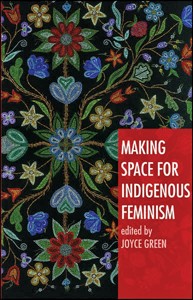 Green, Joyce (ed.) 2007.
Green, Joyce (ed.) 2007.
Making Space for Indigenous Feminism.
Black Point, Nova Scotia, Canada/London,
UK: Fernwood Publishing/Zed
Books (254 pp).
If you have a space you can proceed to fill it. What happens, however, when you have something of vital importance, and there is no space in which to place it? Responses to that extreme situation could range from a broad spectrum of options, from doing one's best with what one has, to collapsing into despair, apathy and self-destruction. One response, though, appears most difficult, and that is to search for a means to actually create a new space; that is a challenging journey.
In Joyce Green's anthology, Making Space for Indigenous Feminism, the reader is presented with explorations of many of those options, most based on the intense and not always positive experiences of the authors. Based on the proceedings of the Aboriginal Feminism Symposium held in 2002 in Regina, Saskatchewan, the book brings together seventeen contributors from almost as many countries, from New Zealand to Canada, Finland to Sweden and the USA. They are Sami, Métis, Maori, Ojibway and Ktunaxa peoples. As contributors, they have taken on the risk involved in chopping out more space, expanding the room for understanding its elusive dimensions.
The overriding impression one receives from the authors' narratives is of the courage and determination that many of them have had to foster in finding a way forward out of their desperate situations. This especially relates to their often lonely circumstances and difficult choices in speaking out on the need for indigenous feminism. As the authors explain, the topics of gender and aboriginal rights, feminism and indigenous peoples' concerns, have not been as straightforward to combine as the uninitiated might imagine. Part of the dilemma lies in the struggle that indigenous peoples have had to endure first in re-creating their own spaces amidst the pervasiveness of colonialism and global modernity, both of which have emerged as partially embedded in each other.
In many respects, most of the arctic, the northern and nordic lands have been the ground for that struggle and, indeed, even the forerunners of some of the most progressive attempts to redress some of the earlier wrongs. The creation of the Inuit-dominated territory of Nunavut, in northern Canada, the relative autonomy of the Greenland Home Rule government, and the steps towards a more autonomous Sameland are all examples of attempts to create new spaces for development of aboriginal society and culture in otherwise occupied territorialities. The steady and substantial energy and determination to achieve those reconfigurations has not come without cost, however, something that each of those societies is now coming to grips with.
One such cost, more obvious to some than to others, has been that the structures of gender relations have undergone numerous changes and not always, according to the authors, to the betterment of women's roles and status. In these detailed accounts, we learn how improvement in the lives of indigenous women has too often been subjugated to the preservation of outward harmony towards the society beyond their own people. There are painful recollections of how many women participated in the struggles to liberate their nations, only to find themselves, once progress was gradually achieved, under new masters, this time in the guise of their own men. How this shift in gender relations took place in the form of silent compacts with the former colonial powers is an unpleasant tale to absorb. Even when women achieved formal equality, as elected members of their newly created parliaments, they were too often expected "to just serve the coffee."
The essential point about this book is that it comes from within the indigenous communities, and that its voices are those of women who have been unable to tolerate their situations any longer. That doing so has in many instances made them 'taboo-breakers', and led to exile from their communities, strengthens the power of their accounts. There is then much for all of us, whatever the northern spaces we inhabit, to learn.
Making Space for Indigenous
Feminism
Book review by: Richard Langlais, previous Senior Research Fellow at Nordregio